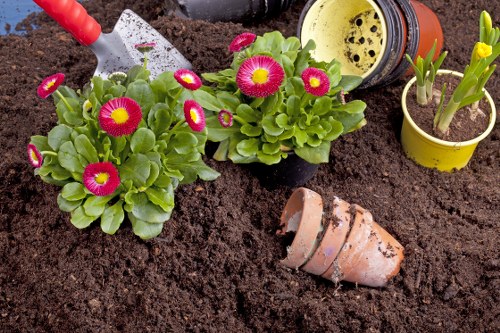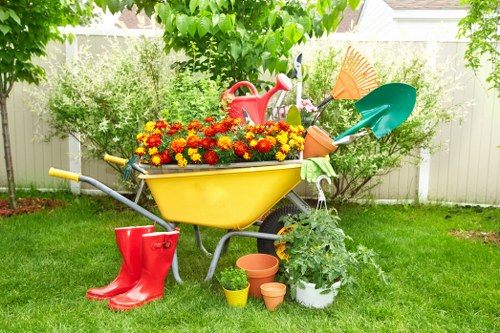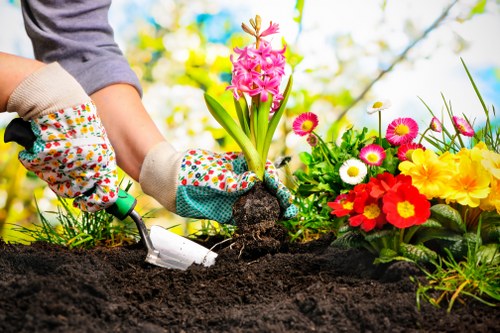Garden Maintenance in Cleaners E15
Introduction to Garden Maintenance

Maintaining a beautiful garden in Cleaners E15 requires a combination of knowledge, dedication, and the right tools. Whether you're an amateur gardener or a seasoned pro, proper garden maintenance ensures that your outdoor space remains vibrant and inviting throughout the year. In this comprehensive guide, we'll explore essential tips and techniques to help you achieve a flourishing garden.
Garden maintenance goes beyond just watering plants. It encompasses a variety of tasks such as pruning, weeding, soil management, and pest control. By regularly attending to these aspects, you can prevent common garden problems and promote healthy plant growth.
One of the key factors in successful garden maintenance is understanding the specific needs of your plants. Different plants thrive under different conditions, so it's important to tailor your maintenance practices accordingly. This ensures that each plant receives the care it needs to reach its full potential.
Essential Tools for Garden Care

Having the right tools makes garden maintenance tasks easier and more efficient. Some of the essential tools every gardener in Cleaners E15 should have include:
- Pruning Shears: Ideal for trimming and shaping plants.
- Garden Gloves: Protect your hands from thorns and dirt.
- Hose and Sprinkler: Ensure your plants receive adequate water.
- Weeder: Remove unwanted weeds without disturbing plant roots.
- Soil Tester: Assess soil pH and nutrient levels for optimal plant health.
Investing in high-quality tools not only improves the efficiency of your garden maintenance but also prolongs the life of the tools themselves. Regular maintenance of your tools, such as cleaning and sharpening, further enhances their performance and durability.
Additionally, organizing your tools in a designated shed or storage area helps keep your garden tidy and ensures that tools are readily available when needed. A well-maintained toolset is crucial for performing garden tasks effectively.
Seasonal Garden Maintenance

Different seasons bring unique challenges and opportunities for garden maintenance. Adapting your gardening practices to each season ensures that your garden remains healthy and beautiful all year round.
Spring
Spring is a time of renewal and growth. Start by clearing any debris left from the winter months and prepare your soil by adding compost or fertilizers. Planting new flowers and vegetables during this season sets the foundation for a bountiful summer.
Summer
During the hot summer months, focus on regular watering and mulching to retain soil moisture and prevent weed growth. Prune overgrown plants and monitor for pests and diseases, addressing any issues promptly to maintain plant health.
Autumn
As temperatures begin to drop, it's important to prepare your garden for the winter. Remove dead plants, rake leaves, and plant cover crops to enrich the soil. Protect sensitive plants by adding mulch or frost covers.
Winter
Winter garden maintenance involves planning for the upcoming year. Prune hardy shrubs, clean your tools, and review your garden layout. This downtime allows you to strategize and make improvements for the spring planting season.
Pest and Disease Management

Effective pest and disease management is crucial for maintaining a healthy garden. Identifying and addressing these issues early can prevent significant damage and loss of plants.
Start by regularly inspecting your plants for signs of pests such as aphids, slugs, and caterpillars. Implement natural pest control methods, such as introducing beneficial insects like ladybugs, which feed on harmful pests.
If pests become a persistent problem, consider using organic or chemical treatments. Always follow the recommended guidelines to ensure the safety of your plants and the environment.
Common Garden Diseases
Garden diseases can spread quickly if not managed properly. Some common diseases include:
- Powdery Mildew: A fungal disease that causes white powdery spots on leaves.
- Blight: Causes rapid browning and death of plant tissues.
- Root Rot: Affects the roots, leading to weakened plants and poor growth.
Preventing diseases involves proper plant spacing, adequate watering practices, and maintaining overall plant health. Removing and disposing of infected plants can also help control the spread of diseases.
Integrated Pest Management (IPM)
Integrated Pest Management (IPM) combines biological, cultural, mechanical, and chemical methods to control pests in an environmentally friendly way. By using a combination of these strategies, you can effectively manage pests while minimizing harm to beneficial insects and the ecosystem.
Soil Health and Fertilization

The health of your garden starts with the soil. Healthy soil provides essential nutrients and a conducive environment for plant roots to thrive. Regular soil testing helps determine nutrient deficiencies and pH levels, allowing you to make informed decisions about soil amendments.
Soil Preparation
Before planting, prepare your soil by loosening it and incorporating organic matter such as compost or aged manure. This improves soil structure, enhances water retention, and promotes beneficial microbial activity.
Fertilization
Fertilizing your garden ensures that plants receive the necessary nutrients for growth and development. Choose fertilizers based on your soil test results and the specific needs of your plants. Organic fertilizers, like bone meal and fish emulsion, provide slow-release nutrients, while synthetic fertilizers offer a quick nutrient boost.
Mulching
Mulching involves applying a layer of organic or inorganic material over the soil surface. Benefits of mulching include moisture retention, temperature regulation, weed suppression, and the addition of organic matter as the mulch decomposes. Common mulch materials include wood chips, straw, and shredded leaves.
Benefits of Healthy Soil
- Enhanced Plant Growth: Nutrient-rich soil supports robust plant development.
- Improved Water Retention: Healthy soil holds moisture effectively, reducing the need for frequent watering.
- Natural Pest Resistance: Strong plants are less susceptible to pests and diseases.
Maintaining soil health is an ongoing process that involves regular testing, appropriate fertilization, and the addition of organic matter. By prioritizing soil care, you lay the groundwork for a thriving garden.
Pruning and Trimming Techniques
Pruning and trimming are essential practices in garden maintenance that help shape plants, remove dead or diseased branches, and encourage healthy growth. Proper techniques ensure that plants remain attractive and productive.
When to Prune
The timing of pruning varies depending on the plant species and the desired outcome. Generally, late winter or early spring is ideal for pruning deciduous trees and shrubs, while summer is suitable for promoting bushier growth in certain plants.
Pruning Tools
Using the right tools is crucial for effective pruning. Common pruning tools include:
- Hand Pruners: For small branches and precise cuts.
- Loppers: Suitable for medium-sized branches.
- Pruning Saws: Ideal for larger branches that require more force.
Pruning Techniques
When pruning, make clean cuts just above a bud or branch junction. Avoid leaving jagged edges, which can make plants more susceptible to disease. Do not remove more than one-third of a plant's foliage at a time to prevent stress.
Benefits of Pruning
- Promotes Air Circulation: Reduces the risk of fungal diseases by allowing better airflow.
- Enhances Flowering: Stimulates the growth of new flowers and fruits.
- Maintains Shape: Keeps plants looking neat and well-maintained.
Regular pruning and trimming are integral to maintaining a healthy and aesthetically pleasing garden. By following proper techniques, you ensure that your plants remain strong and vibrant.
Advanced Pruning Tips
For more experienced gardeners, advanced pruning techniques such as coppicing and pinching can be employed to encourage specific growth patterns and increase plant productivity. These methods require a deeper understanding of plant biology and careful execution to achieve the desired results.
Irrigation and Water Management
Efficient irrigation and water management are vital components of garden maintenance. Proper watering practices ensure that plants receive adequate moisture without wasting water resources.
Types of Irrigation Systems
Several irrigation systems are suitable for gardens in Cleaners E15, each with its own advantages:
- Drip Irrigation: Delivers water directly to the plant roots, minimizing evaporation and runoff.
- Sprinkler Systems: Cover larger areas, ideal for lawns and expansive garden beds.
- Soaker Hoses: Simple and flexible, allowing water to seep slowly along the hose length.
Choosing the right irrigation system depends on the size of your garden, the type of plants, and your water conservation goals. Combining multiple systems can provide comprehensive coverage and flexibility.
Watering Techniques
Effective watering techniques involve watering deeply and less frequently to encourage deep root growth. Early morning is the best time to water, reducing the risk of evaporation and fungal diseases. Avoid watering during the hottest part of the day to prevent water loss.
Water Conservation Tips
Implementing water conservation strategies helps maintain a sustainable garden while reducing water bills. Some effective tips include:
- Mulching: Retains soil moisture and reduces the need for frequent watering.
- Rainwater Harvesting: Collect rainwater for garden use, minimizing reliance on municipal water sources.
- Smart Irrigation Controllers: Automate watering schedules based on weather conditions to optimize water usage.
Benefits of Proper Water Management
- Healthy Plant Growth: Ensures that plants receive the right amount of water for optimal development.
- Reduced Water Waste: Efficient irrigation systems minimize water loss through evaporation and runoff.
- Environmental Sustainability: Conserves water resources and promotes eco-friendly gardening practices.
By prioritizing efficient irrigation and water management, you can maintain a lush and thriving garden while contributing to environmental conservation.
Lawn Care and Maintenance
A well-maintained lawn enhances the overall appearance of your garden and provides a lush, green backdrop for other plants. Proper lawn care involves regular mowing, fertilizing, aerating, and pest control.
Mowing Practices
Mowing your lawn regularly helps promote even growth and a healthy appearance. Set your mower to the appropriate height for your grass type, typically between 2.5 to 3.5 inches. Avoid cutting more than one-third of the grass blade at a time to prevent stress.
Fertilization
Fertilizing your lawn provides essential nutrients that support strong root systems and vibrant green blades. Choose a fertilizer suited to your grass type and follow the recommended application rates to avoid over-fertilization, which can lead to weed growth and environmental harm.
Aeration
Aerating your lawn involves perforating the soil to improve air, water, and nutrient penetration. This practice helps alleviate soil compaction, promoting healthier grass growth and reducing the risk of turf diseases.
Pest and Weed Control
Managing pests and weeds is essential for maintaining a healthy lawn. Regularly inspect your lawn for signs of pests such as grubs and armyworms, and implement appropriate control measures. Use selective herbicides to target weeds without harming the grass, or opt for manual removal for smaller infestations.
Benefits of a Healthy Lawn
- Enhanced Curb Appeal: A green, well-kept lawn boosts the aesthetic value of your property.
- Soil Erosion Prevention: Grass roots bind the soil, reducing the risk of erosion.
- Environmental Benefits: Lawns contribute to air purification and provide habitats for beneficial insects.
Consistent lawn care ensures a resilient and attractive lawn that complements your overall garden design.
Advanced Lawn Care Techniques
For those seeking to take their lawn care to the next level, consider implementing practices such as overseeding, topdressing, and integrating native grass species. These techniques enhance lawn density, improve soil structure, and promote biodiversity.
Plant Selection and Garden Design
Choosing the right plants and designing your garden layout are fundamental aspects of garden maintenance. Thoughtful plant selection ensures compatibility with local climate conditions, soil types, and aesthetic preferences.
Choosing the Right Plants
Select plants that are well-suited to the Cleaners E15 climate and soil. Consider factors such as sunlight exposure, water requirements, and hardiness zones. Opting for native plants can reduce maintenance efforts and support local biodiversity.
Garden Layout and Design
A well-designed garden layout enhances both functionality and visual appeal. Incorporate elements such as pathways, seating areas, and focal points to create a balanced and inviting space. Use a mix of plant heights, colors, and textures to add depth and interest.
Companion Planting
Companion planting involves growing mutually beneficial plants together to improve growth, deter pests, and maximize space. For example, planting marigolds alongside vegetables can repel harmful insects, while beans and corn can support each other's growth.
Year-Round Interest
Design your garden to have year-round interest by incorporating plants that bloom in different seasons, evergreen foliage, and decorative elements such as sculptures or water features. This ensures that your garden remains attractive even during the off-season.
Benefits of Thoughtful Garden Design
- Optimized Plant Health: Proper plant placement enhances growth and reduces competition for resources.
- Enhanced Aesthetics: A cohesive design creates a visually pleasing outdoor space.
- Increased Functionality: Thoughtful layout improves garden usability and accessibility.
Investing time in plant selection and garden design pays off in the long run, resulting in a sustainable and beautiful garden that meets your needs and preferences.
Sustainable Gardening Practices
Incorporating sustainable practices into your garden design not only benefits the environment but also reduces maintenance efforts. Techniques such as rainwater harvesting, composting, and using organic fertilizers contribute to a healthier garden ecosystem.
Professional Garden Maintenance Services
While DIY garden maintenance is achievable, enlisting professional garden maintenance services in Cleaners E15 can provide expertise and save you time. Professionals bring knowledge of local climate conditions, soil types, and plant species, ensuring optimal garden health.
Professional services offer a range of benefits, including:
- Expertise: Skilled gardeners can identify and address issues that may be overlooked by amateurs.
- Time-Saving: Delegating maintenance tasks frees up your schedule for other activities.
- Customized Care: Professionals tailor their services to meet the specific needs of your garden.
Services Offered
Typical garden maintenance services include:
- Regular lawn mowing and edging.
- Pruning and trimming of shrubs and trees.
- Weeding and mulching garden beds.
- Soil testing and fertilization.
- Seasonal planting and garden clean-up.
Additionally, some services may offer specialized treatments such as pest control, irrigation system installation, and landscape design consultation.
Choosing the Right Service
When selecting a professional garden maintenance service, consider factors such as experience, reputation, service offerings, and pricing. Reading reviews and seeking recommendations from neighbors can help you find a reliable and trustworthy provider.
Long-Term Benefits
- Consistent Care: Regular maintenance ensures that your garden remains healthy and attractive over time.
- Increased Property Value: A well-maintained garden enhances the overall appeal of your property.
- Stress Reduction: Professional services alleviate the burden of garden upkeep, allowing you to enjoy your outdoor space without worry.
Investing in professional garden maintenance services is a smart choice for those seeking a hassle-free and expertly managed garden in Cleaners E15.
How to Collaborate with Garden Professionals
Effective collaboration with garden maintenance professionals involves clear communication of your preferences, regular updates on garden progress, and a mutual understanding of maintenance goals. Establishing a good working relationship ensures that your garden receives the care and attention it deserves.
Contact us today to learn more about our professional garden maintenance services and take the first step towards a stunning and well-maintained garden in Cleaners E15.
Conclusion
Garden maintenance in Cleaners E15 is a rewarding endeavor that enhances the beauty and functionality of your outdoor space. By following the tips and techniques outlined in this guide, you can achieve a thriving garden that brings joy and tranquility to your home.
Remember that consistent care, the right tools, and informed decision-making are key to successful garden maintenance. Whether you choose to maintain your garden yourself or enlist professional services, investing time and effort into your garden will yield lasting benefits.
Don't wait to transform your garden into a lush, vibrant haven. Book your service now and experience the difference that expert garden maintenance can make.


